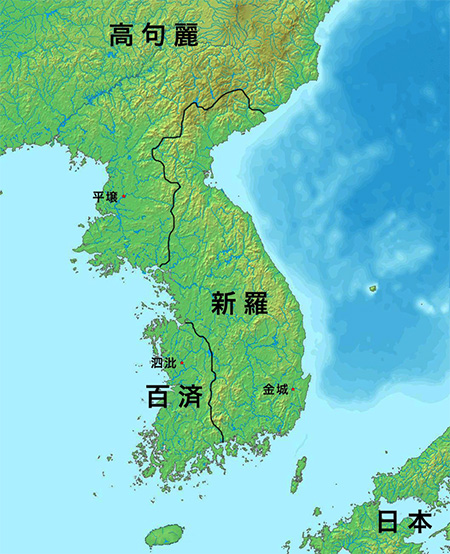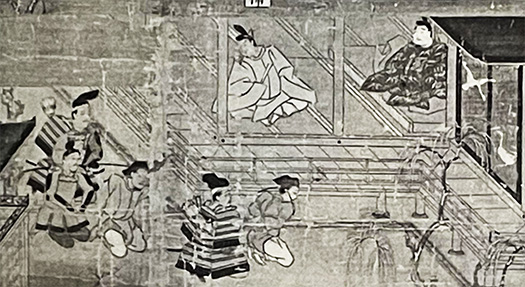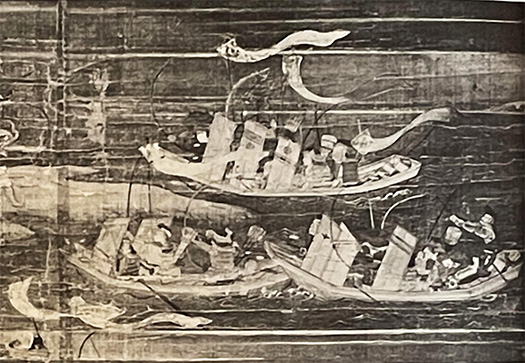


法隆寺宝物館「聖徳太子絵伝」記事、第14回目は聖徳太子の生きた時代の東アジア情勢と新羅との戦争について。このシリーズの第一回はこちら→端正なモダニズム「法隆寺宝物館」探訪。
聖徳太子が生きた時代(572-622年)は、中国大陸では対外的に強勢的な隋が建国(581年)そしてそれが短期間で滅亡する(619年)時代にあたっている。そして朝鮮半島では、576年当時、図のように3カ国の鼎立状態・いわゆる三韓時代に相当している。
そういう時代背景のなかで日本は畿内と北九州地域を結ぶ中心地域でようやく「中央政権」が確立していた段階。東アジア地域から土地を求めて移民が押し寄せていた時代だった。一例として中国大陸に成立し滅亡した「秦」の末裔が「秦氏」として日本各地に地名痕跡が存在している。
そして大量の人口を養いうる生産手段としての水田農耕が拡大し、その管理統御が政権の基本的な成立基盤だったことだろう。水田農耕の推進には水田を土木造作して水利を確保し、さらに田植え、稲刈りなどの農作業の集団管理が不可欠だった。巫女のように田植えの時期を明示指示することが絶対に必要。卑弥呼の存在意義か。
必然的に中国大陸で生産が旺盛になった「鉄器」が最重要戦略物資であって、それはまだ日本国内生産が十分ではなく、ひたすら朝鮮半島からの輸入に依存していた。
朝鮮半島では釜山の福泉洞古墳群などで4世紀の中ごろに「鉄てい」という両端が幅広になった長方形の鉄板が出現。鉄ていはいろいろな鉄製品を作る素材。4世紀末には日本にも輸入されている。日本にもたらされた鉄ていの多くは、朝鮮半島南部で作られたと推定される。これらのいわば産業革命の背後には朝鮮半島からの技術者集団の渡来があったことは間違いない。この時期に朝鮮半島地域との政治的な関与が大きいのはそうした事情。
こういった背景の中にあって聖徳太子はいわば「開明派」として積極的に仏教を導入し、海外との外交関係強化に努めていた。そしてとくに重要な朝鮮半島地域との外交に精力を傾けていたと言える。
外交方針については当時も今も変わらずに政権基盤と関わっていて、国内政治上の対立としてもあった。聖徳太子は反新羅の姿勢を鮮明にし、とくに百済との関係を強化していったと思われる。
2枚目の聖徳太子絵伝中の絵は、新羅の間諜を捕らえて尋問している様子。任那日本府という朝鮮半島での日本の国益の足場が新羅によって滅亡させられるなどの緊張状態が続く中で、こういったスパイ戦や、緊張の沸騰点として「新羅征伐(600年)」も発生した。3枚目の絵伝の絵は海軍船舶による攻撃の様子。
仏教の導入政策は、こういった外交情勢も背景的事情として国策化していった。ヤマト王権として政権基盤を固めるために利用されたとも言えるのだと思う。聖徳太子の現実政治家としての側面でもあるのだろう。
English version⬇
Resource Diplomacy Concerning Iron and the Conquest of Silla: The Gallery of Horyuji Treasures-14
Stabilization of iron imports, essential for rice production, was the foundation of the regime. Understanding the situation on the Korean peninsula and getting involved was an extremely important diplomatic theme for Japan at the time.
The fourteenth article in the Horyuji Treasury “Shotoku Taishi E biography” series discusses the situation in East Asia during Shotoku Taishi’s lifetime and his war with Silla.
The period in which Prince Shotoku lived (572-622) corresponds to the period in which the powerful Sui Dynasty (581) was founded in mainland China and was destroyed in a short period of time (619). On the Korean peninsula, the year 576 corresponded to the so-called Three Hans Period, when three countries were in a state of triumph, as shown in the figure.
Against this background, Japan was at the stage of finally establishing a central government in the central region connecting the Kinai and Kitakyushu regions. It was a time when immigrants were pouring in from East Asia in search of land. As an example, the descendants of the “Qin” clan, which was established and destroyed on the Chinese continent, are known as the “Hata” clan, and their place names and traces exist in various parts of Japan.
Paddy field agriculture expanded as a means of production that could feed a large population, and its management and control was probably the basic foundation for the establishment of the regime. In order to promote paddy field agriculture, it was essential to secure water supply by constructing paddy fields, and to collectively manage rice planting, harvesting, and other farming activities. It is absolutely necessary to give explicit instructions on the timing of rice planting like a shrine maiden. The significance of Himiko’s existence?
Inevitably, the most important strategic commodity was “ironware,” which was produced vigorously on the Chinese mainland, but which was not yet sufficiently produced in Japan, and was solely dependent on imports from the Korean Peninsula.
On the Korean Peninsula, rectangular iron plates with wide ends called “tetsutei” appeared in the middle of the 4th century at the Bokcheondong burial mounds in Busan and other sites. Tetsutei were imported to Japan at the end of the 4th century. It is estimated that most of the tetsutei brought to Japan were made in the southern part of the Korean Peninsula. There is no doubt that a group of engineers from the Korean Peninsula came to Japan behind these so-called industrial revolutions. This is the reason why political involvement with the Korean Peninsula was so important during this period.
Against this backdrop, Prince Shotoku actively introduced Buddhism as an “open-minded” leader and made efforts to strengthen diplomatic relations with foreign countries. In particular, he devoted his energies to diplomacy with the Korean Peninsula, which was an important region.
His foreign policy was then, as it is now, related to his regime base, and it was also a domestic political conflict. It is thought that Prince Shotoku made his anti-Silla stance clear and strengthened his relationship with Baekje in particular.
The second picture in the Shotoku Taishi Pictorial Biography shows Prince Shotoku capturing and interrogating a Silla counterintelligence officer. The third picture in the pictorial biography shows an attack by naval vessels.
The policy of introducing Buddhism became a national policy in the context of these diplomatic developments. I think it can be said that the Yamato kingdom used this policy to consolidate its political base. This may be the aspect of Prince Shotoku as a real politician.
Posted on 6月 11th, 2023 by 三木 奎吾
Filed under: 歴史探訪







コメントを投稿
「※誹謗中傷や、悪意のある書き込み、営利目的などのコメントを防ぐために、投稿された全てのコメントは一時的に保留されますのでご了承ください。」
You must be logged in to post a comment.